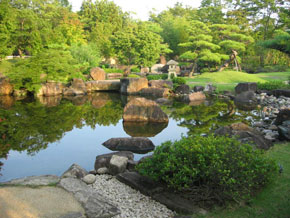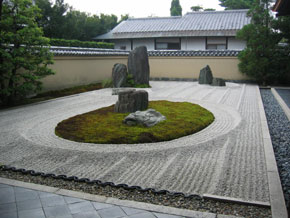Kyoto is home to some of the most beautiful and most well-known Japanese dry landscape gardens (Karesansui). Many of these are located within temple complexes in central Kyoto and can be reached on foot or by local bus.
Japanese dry landscape gardens are not to everyone’s taste, with some consisting only of gravel raked into lines or patterns. But taken into context; the history and age of these gardens, together with the deeper meaning symbolised by the gravel and rocks, and you will no doubt find them fascinating.
There are numerous ways of deconstructing the layout and planning of these gardens and you will often find small wooden signs next to the garden explaining what the garden depicts. But, even without delving into such deep spiritual meanings, you can enjoy the beauty and serenity of these photogenic gardens for what they are: visually beautiful spaces.
- Bowdoin College web site on Japanese gardens. This excellent website is dedicated to Japanese gardens and focuses primarily on the historic gardens of Kyoto and its environs, including Nara. There are about 29 Karesansui featured, with photos and explanations.
Daitoku-ji Temple
Daitoku-ji Temple complex sits at the north west side of Kyoto and is reached via a 5-10 minute bus ride from Kitaoji Station. Established at the beginning of the 14th Century, Daitokuji is part of Rinzai Sect of Buddhism. Within it’s walls, you will find many subtemples and gardens accessible to the public, the most famous of which is Daisen-in and Koto-in.
The sign next to Ryogen-in garden (photo: right) says, ‘Zen garden of dry landscape. The oldest in Daitokuji. A sheet of moss shows the water and the stone projecting in the centre symbolise ‘shumisen’, which is thought to be the core of the universe. In Buddhism, this universe is thought to consist of eight seas and nine mountains.’
For details of budget Ryokans in Kyoto plus a link to Tani House Ryokan which is next to Daitoku-ji, see our Accommodation section.


